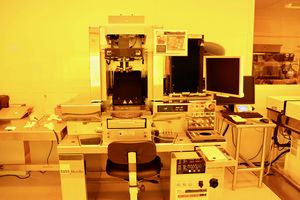Difference between revisions of "SUSS MicroTec MA6 Gen3 Mask Aligner"
(update tool owner) |
(update to NEMO) |
||
| Line 11: | Line 11: | ||
| Tool_Manufacturer = SUSS MicroTec | | Tool_Manufacturer = SUSS MicroTec | ||
| Tool_Model = MA6 Gen3 | | Tool_Model = MA6 Gen3 | ||
| − | | | + | | NEMO_Designation = MA-01 |
| Lab_Phone = XXXXX | | Lab_Phone = XXXXX | ||
| SOP Link = [https://www.seas.upenn.edu/~nanosop/MA6_SOP.htm SOP] | | SOP Link = [https://www.seas.upenn.edu/~nanosop/MA6_SOP.htm SOP] | ||
Revision as of 14:11, 3 January 2024
 |
|
| Tool Name | SUSS MicroTec MA6 Gen3 Mask Aligner |
|---|---|
| Instrument Type | Lithography |
| Staff Manager | Ana Cohen |
| Lab Location | Bay 2 |
| Tool Manufacturer | SUSS MicroTec |
| Tool Model | MA6 Gen3 |
| NEMO Designation | MA-01 |
| Lab Phone | XXXXX |
| SOP Link | SOP |
Description
This system is a dual-use mask aligner and wafer-bond aligner. Mask alignment is used for contact and proximity exposure processes. Exposures can be performed with gaps programmable from 10 um to 300 um in 1 um increments. Automatic wedge error compensation (WEC) is used to ensure that the mask and wafer are parallel. The lamp is a 1000 W Hg-Arc lamp. Integrated light level sensing ensures proper exposure doses as the lamp degrades.
Applications
- Photomask exposure of resist-coated samples
Processes
Exposure Parameters
The following should help narrow down potential exposure parameters based on resist type and thickness. Information based on the following resist datasheets -- S1800 Series, SPR 220 Series, SU-8 2000-2015, SU-8 2025-2075, SU-8 2100, SU-8 3000.
| Resist | Thickness (um) | Dose (mJ/cm2) | Channel |
|---|---|---|---|
| S1813 | 1.2 | 150 | #2 |
| SPR220 - 3.0 | 3.0 | 310 | #1 |
| SPR220 - 4.5 | 5.0 | 380 | #1 |
| SU-8 2005 | 5.0 - 6.0 | 105 - 110 | #1 |
| SU-8 2050 | 40 - 80 | 150 - 215 | #1 |
| 80 - 110 | 215 - 240 | #1 | |
| 115 - 160 | 240 - 260 | #1 | |
| SU-8 2100 | 100 - 150 | 240 - 260 | #1 |
| 150 - 225 | 260 - 350 | #1 | |
| 225 - 270 | 350 - 370 | #1 | |
| SU-8 3050 | 40 - 100 | 150 - 250 | #1 |
Exposure Wavelengths
The software adjusts the lamp intensity controller during exposure based on the channel selected in the recipe.
- Channel #1 = 365nm (i-line)
- Channel #2 = 405nm (h-line)
For some applications it can be beneficial to eliminate wavelengths below 365nm using a long pass filter. Contact staff to be trained on setting this filter if you plan to use it. Since higher energy wavelengths are removed, expect an increase in exposure time of approximately 40% to reach the optimum exposure dose.
Resources
SOPs & Troubleshooting
- QNF SOP
- If the recipe cannot be changed directly with the recipe button it typically means that the user management software has been logged out. To fix it, do the following:
- Minimize the main software
- Open the 'User Management' software on the desktop
- Login with username:user and no password